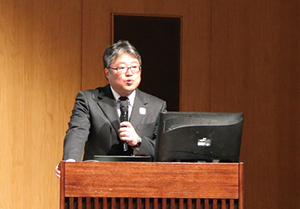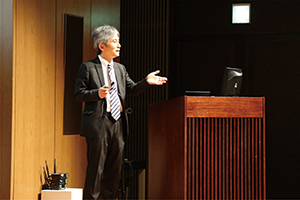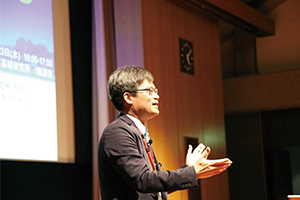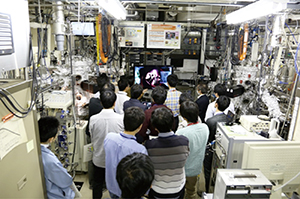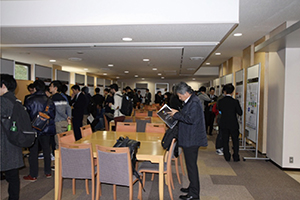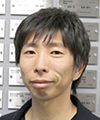 |
|
|
|
|
|
Information Vol. 15, No. 6, pp. 54–56, June 2017. https://doi.org/10.53829/ntr201706in1 Event Report: Science Plaza 2016 at NTT Basic Research LaboratoriesAbstractScience Plaza 2016, an open-house event hosted by NTT Basic Research Laboratories, was held at NTT Atsugi R&D Center on November 23, 2016. Under the banner “Frontier Science: Open Door to the Future,” Science Plaza was aimed at disseminating our latest research accomplishments to various groups of people inside and outside of NTT as well as gathering diverse opinions. This event was held jointly with NTT Device Innovation Center, NTT Device Technology Laboratories, and NTT Communication Science Laboratories. Keywords: NTT Basic Research Laboratories, Science Plaza, open-house event 1. Purpose of Science PlazaAt NTT Basic Research Laboratories (BRL), we are engaged in research aimed at creating new principles and concepts that overcome the limitations of existing network technology and developing basic technologies that pave the way to future innovation. At Science Plaza 2016, our aim was to introduce to a wide audience the results of the cutting-edge research being carried out not only at BRL, but also at NTT Device Innovation Center (DIC), NTT Device Technology Laboratories (DTL), and NTT Communication Science Laboratories (CSL). This event was chiefly targeted at undergraduate and postgraduate students and corporate researchers. 2. Science Plaza overviewThe event included lectures, poster exhibitions, and laboratory tours, which are briefly introduced here. 2.1 LecturesAt Science Plaza 2016, the lectures were divided into morning and afternoon sessions. The morning session started with an opening address delivered by BRL director, Tetsuomi Sogawa (Photo 1). This was followed by three lectures: Frontier Research in Quantum Electronic Optical Properties and Functional Materials (BRL), Groundbreaking New Device Research (DIC/DTL), and Communication Science as a Bridge Between Humans and Information (CSL). After that, Dr. Akira Fujiwara (Senior Distinguished Scientist, BRL) held a symposium called Ultimate Electronics Using Nano-devices (Photo 2). This symposium lecture covered the prior development of silicon devices, the current state of research into silicon nano-devices at BRL, and the prospects for future development aimed at practical applications.
In the afternoon session, the 2014 winner of the Nobel Prize in Physics, Dr. Hiroshi Amano (Director, Center for Integrated Research of Future Electronics, Institute of Materials and Systems for Sustainability, Nagoya University), was invited to deliver a special lecture entitled Illuminating the World by LEDs (Photo 3). In this lecture, Dr. Amano talked about what happened immediately after the Nobel prize was announced, the problems he encountered in the research and development of blue light emitting diodes, the factors behind his eventual success, and the prospects for future development. The lecture theater was filled to capacity in both the morning and afternoon lecture sessions, and the lectures were followed by lively question and answer sessions.
2.2 Lab toursWe held lab tours to show the attendees around facilities such as the clean room and laboratories where our research actually takes place, and to allow them to experience some of our latest research achievements (Photo 4). There were a total of ten tours (three from BRL, six from DIC/DTL, and one from CSL), each of which was run twice. All the tours were fully booked (with ten guests each), making a total of 200 participants in the lab tours. These tours were very well received, and the feedback questionnaires included responses such as “I don’t often get the chance to visit commercial laboratories. This was a really educational experience.”
2.3 Poster exhibitionWe put on an exhibition of posters illustrating 52 research projects, including 13 from the joint research institutes, and the researchers involved in these projects were introduced directly to the exhibition visitors (Photo 5). The exhibition started with an overview of each research project and went on to describe in detail the originality and impact of the research and its future prospects, including an in-depth discussion of the research.
After all the lectures, exhibitions, and announcements were finished, we rounded off the event with an evening social gathering in the exhibition hall. This gave us a chance to get to know the visitors better and continue with the discussions on our research. 2.4 Conclusion of Science Plaza 2016Science Plaza 2016 was attended by 198 visitors from universities, research institutes, private companies, NTT Group companies, and other organizations. We are really grateful to everyone who attended this event. The questionnaires filled in by those who attended the poster exhibition and lab tours will provide valuable feedback for the next Science Plaza. |
|









